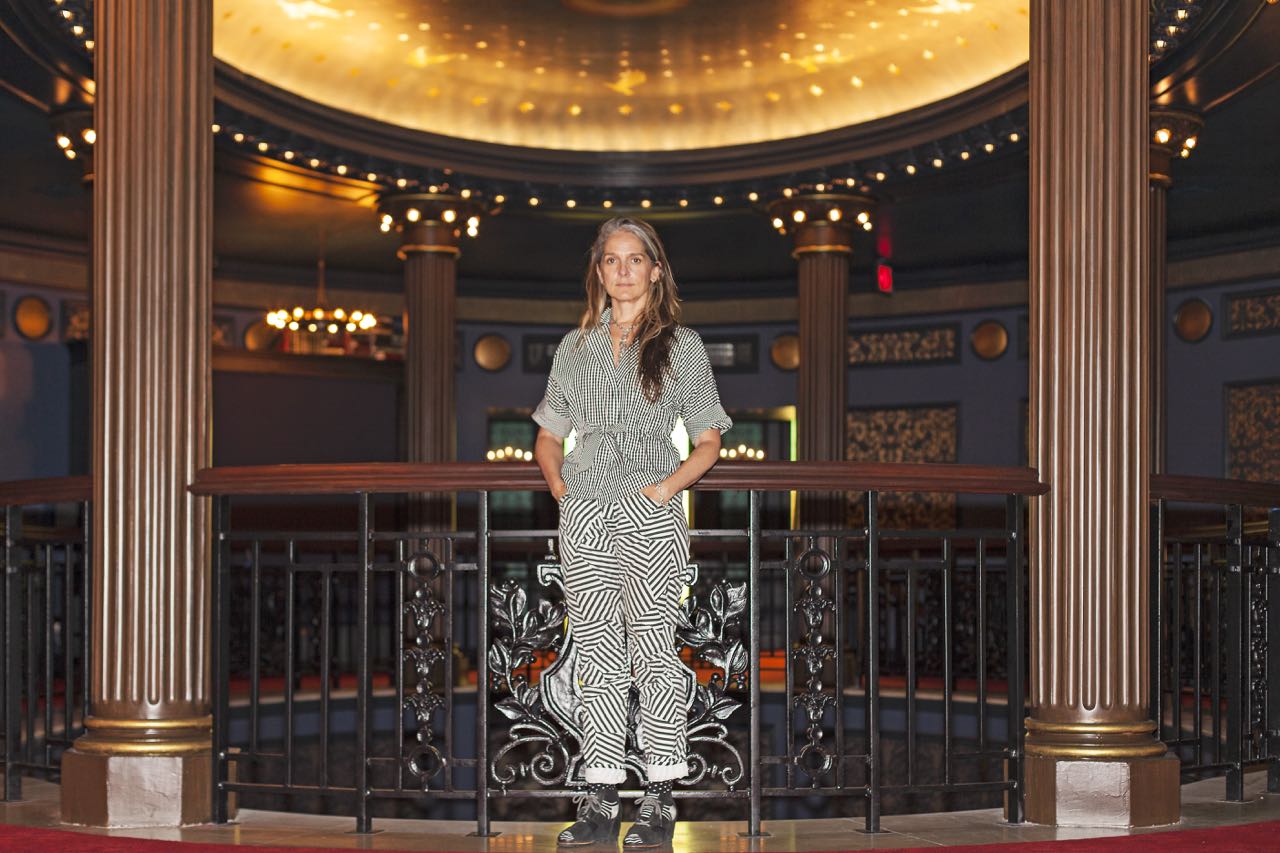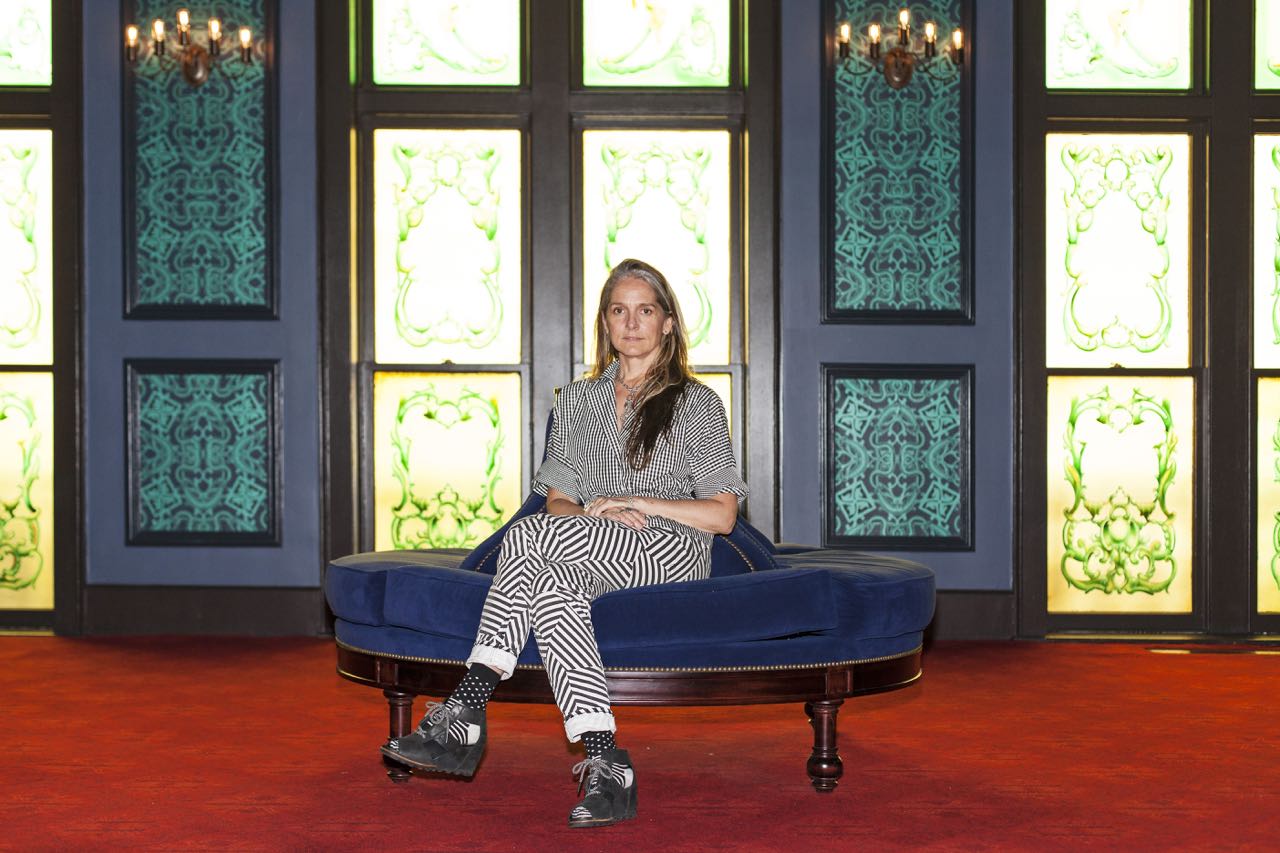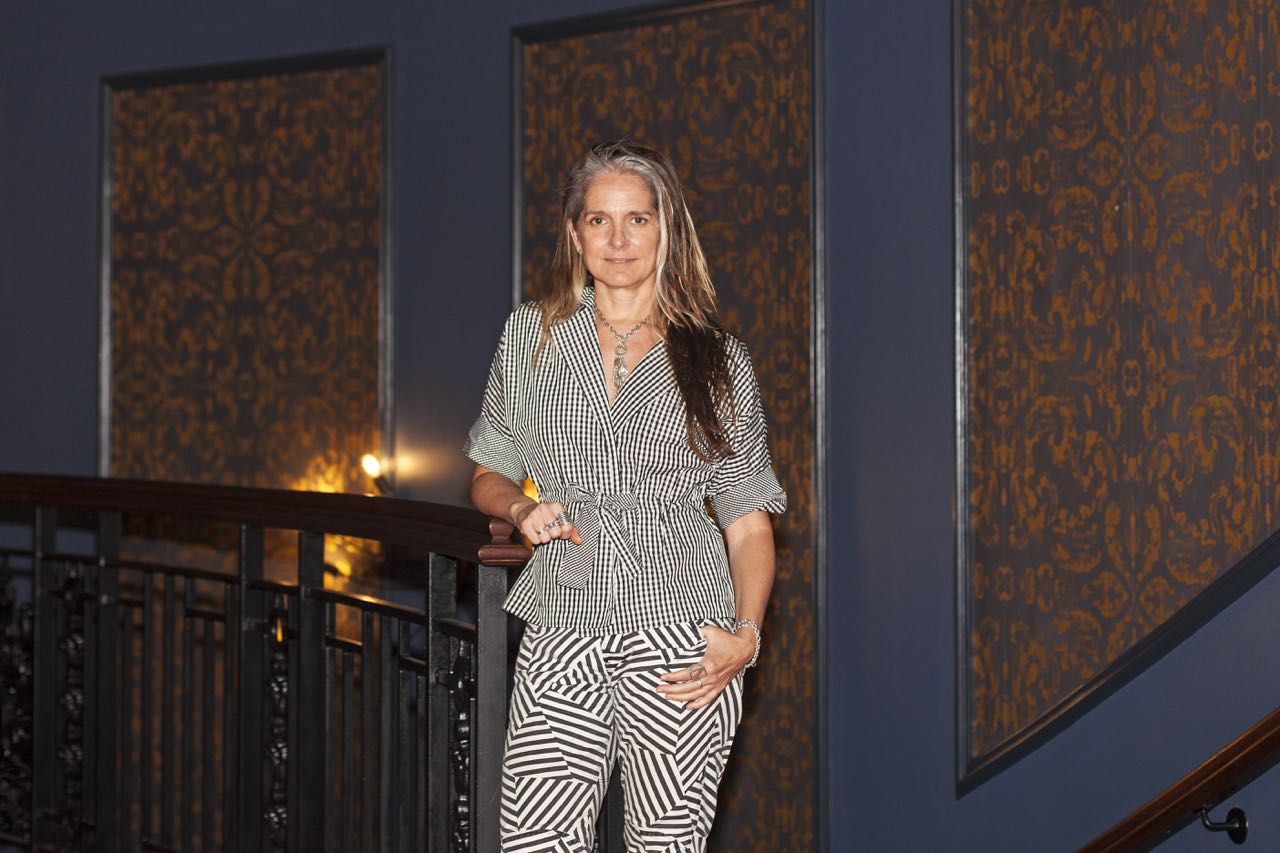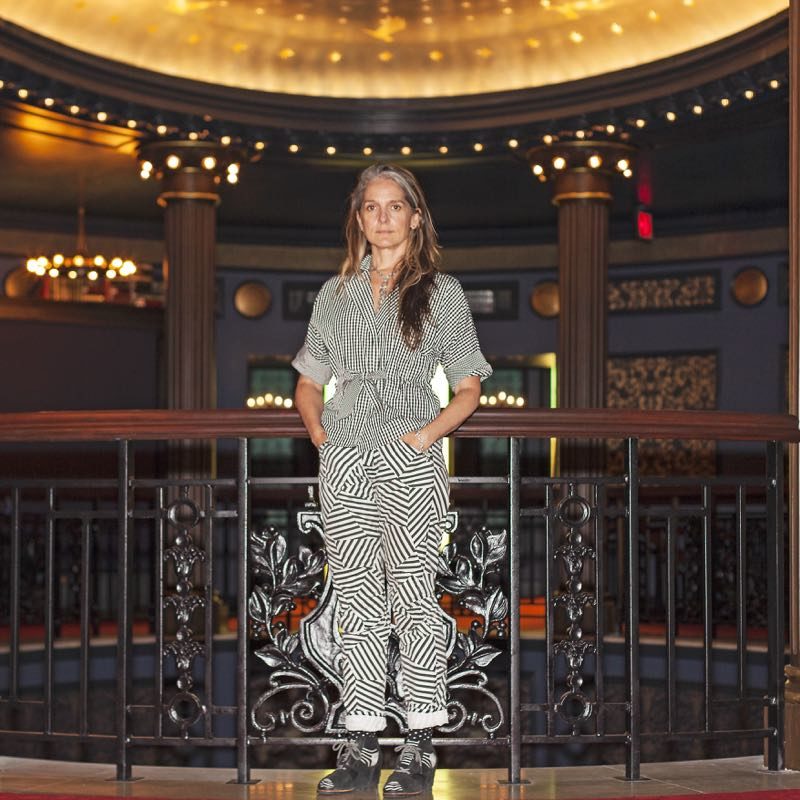An Interview with Set Designer Christine Jones

Interview by Sarah Rebell and Maria Resavage
May 31st, 2018
Eight times a week, there is magic happening at Broadway’s Lyric Theatre. I am referring not to the wizards and wands and spells, which, after all, are fantasy, but rather to the imaginative, elegant set, full of secrets and illusions, upon which the play Harry Potter and the Cursed Child occurs. This set is the work of designer Christine Jones, who has been nominated for a 2018 Tony Award for her creation. Christine is also the recipient of a 2015 Obie Award for Sustained Excellence in Design. Her other credits include American Idiot, for which she won a 2010 Tony Award, and the original Broadway production of Spring Awakening. I, along with 2018 FIT design graduate and aspiring set designer Maria Resavage, recently sat down with Christine, in a room right off the spectacularly renovated Victorian gothic lobby of the Lyric, to discuss Christine’s approach to designing the set for the well-known and beloved wizarding world, how her kids have impacted and shared in her experience of Harry Potter, her impressions of the ways in which the field of set design has changed for young women who are just starting out, and more.
This conversation has been edited and condensed.
You were raised in Montreal, which is a UNESCO design city. Growing up, were there elements of your visual experience that stimulated your interest in design?
More than the architecture or the visual elements of Montreal, I would say it was the overall vibrancy of the city as a creative hotbed for many different kinds of art. It was seeing some of the productions by iconic theatre directors, like Robert Lepage and Gilles Maheu, who were creating work in Quebec and Montreal when I was in college at Concordia University. Those were the things that blew my mind away. There was also an international theatre festival every other year, and there were international companies coming [to Canada] during that festival that were also incredibly exciting.
Is there any specific style or aesthetic that you tend to look for in the work that you choose to design?
Certainly music does draw me in. I mean, I never set out to do musicals. In Canada, we didn’t have the same tradition of doing musicals in high school. I didn’t know much of the American musical theatre canon, even when I came to New York. I grew up doing Shakespeare in high school. Even when I came to New York, there wasn’t a sense that I was destined or hungry for Broadway. But I love to listen to music. I love to go to concerts. And when Michael Mayer asked me to do Spring Awakening, it was the score that really drew me in. And [with] American Idiot, getting to work on something that really is an iconic rock album was particularly exciting. Then, also, working with specific people is a lot of what excites me as well. Once I started working with Michael, we continued to work together and still do. What’s great about Michael is that he does opera, and musicals, and punk rock musicals, and plays, so it’s given me an opportunity to work in many different forms with him. And, there’s no better dance partner than [Harry Potter’s movement director] Steven Hoggett. My particular passion is working with directors and choreographers who interact with the scenery and bring it to life, almost like another character.
What about when you’re working on Theatre For One, for which you’re the artistic director? How does that process affect your collaboration dynamic?
Well, Theatre For One began as an experiment. Because I am always thinking about the relationship between the audience and the actor, I wanted to experiment with what happens when you distill that relationship down to its most intimate form. In that instance, the set becomes significantly less important than the space itself. It’s all about the spatial relationship. For that project, I collaborated with architects, because even though it was a small building, I had this awareness that I was building a building, not a set. I wanted to collaborate with architects, not set designers. That gave me an opportunity to work with other designers and have that collaboration, which is not a collaboration that I normally get to experience, because usually I’m in that role. We have found in our productions that you’re so focused on the actor that what’s happening around them fades into the background, so we tend to keep the set design minimal and let it be all about the relationship that the space itself creates.
It’s ironic that the process of building the theatre for your Theatre For One may have prepared you, in some ways, for the experience of renovating the Lyric Theatre for a show that obviously has a very large audience.
I think that doing Theatre For One has made me more aware of what I call the visual acoustics of a space. Whether it’s one seat or fifteen hundred seats, part of my job as a designer is to maximize the intimacy of the relationship between the audience and the actors onstage.
I actually first came across Theatre For One when I read a piece about you and your kids up at SPACE on Ryder Farm. It’s so great that you’ve been able to participate in a residency program that supports moms who are working in the theatre. Could you talk a bit about your experience with SPACE?
We went up during some of SPACE’s first few years. I was invited there by Emily Simoness, whom I knew personally. I asked her if I could bring the kids, and she said sure. I went with the kids, and I brought a caretaker to come with me so I could spend half the day working and half the day playing with the kids. So we shared the responsibility. But since then, inspired by that, Emily partnered with The Lilly Awards to create a family program. Every summer now, there are two weeks in SPACE’s program that are dedicated to families coming, and they’ve created a program for the kids to participate in. I’m really excited that, in some ways, we founded that idea. As my kids have gotten older, it’s easier to bring them to work and have them observe tech. Sometimes they’re more excited about it, sometimes less excited. For Harry Potter, they were pretty excited. I invited [my son] Pilot to draw wands with me. I invited Ever, my youngest, to paint diagrams on the set with me. I try to share with them what my life is. When they were really young, they’d say, “Mommy do you have to go to work?” I would say, “I’m not going to work, I’m going on a playdate. I’m also going to play with my friends.” So I hope that they grow up with the sense that work can be something you enjoy and relish in. I do remember once when we were at Ryder Farm, I was trying to carve out some time to get some particular work done with [Theatre For One director] Jenny Koons who was there with me. At one point, Ever kept coming over. And I was like, “Mommy’s in her work bubble.” And he went “Pop.” Well, okay, I like the imagination.
Were your kids the ones who originally introduced you to Harry Potter?
They were, absolutely. I read the first three books to them, and then my tongue was tired, and we started listening on audiobooks. We listened to Stephen Fry’s recordings, which are virtuosic and remarkable. So, before I had any inkling that I would be asked to work on this project, we had listened to all the books together. Our rule was that we couldn’t watch a movie until we had read the book. We would read the book, watch the movie, read the book, watch the movie. And my youngest son, from a very early age, even before we read the books or saw the movies, was obsessed with Harry Potter and wouldn’t leave the house unless I drew glasses and a lightning bolt on his forehead. So, it was pretty amazing to then, some years later, find myself immersed in this world. And we were all pretty excited when this opportunity came along.
The experience of being a parent is very thematically significant in Cursed Child. And although Harry Potter has become an extremely well-known franchise, at the start of it, the books were originally written by an impoverished single mom who was trying to support her family.
I felt keenly aware of that while I was working on that production. And keenly aware that J.K. Rowling’s opus was giving me a chance to flourish, and take on huge challenges, and enter a phase of my own career where I was being given an opportunity to really thrive. I thought about that a lot.

I’m not going to approach this next question in a straightforward way, because I’m sure you’ve gotten it many times before. Instead of asking which Hogwarts House you would sort yourself into, I’d like to know into which house you think your kids would sort you into.
That’s interesting. I feel like they might put me in Gryffindor, but I’m actually in Hufflepuff. I hope I’m not overstepping my sense of my own self in their eyes, but I’m going to ask them that question when I go home tonight. [Note: Christine’s kids seem to know her very well; they actually sorted her into Hufflepuff.] Everybody got sorted, and we had our own games going on during the rehearsal process. The stage managers organized it. People in the different houses could win and lose points throughout the rehearsal process.
Hogwarts has a Frog Choir and school dances, like the Yule Ball, but they don’t seem to have a Drama Club or ever put on any plays. Do you think there’s a reason for that? Do theatricality and magic somehow cancel each other out?
Is it that the theatre of your life as a wizard is so extraordinary that there’s less of a need to pretend to be somebody else? If you can literally turn into someone else, then do you need theatre to pretend to be somebody else? It’s a really excellent question that I don’t know the answer to. But next time I see [playwright] Jack Thorne, I’m going to ask him if he has any thoughts about that.
After reading the books and seeing the movies with your kids, you must have had an unusually in-depth familiarity with the world of the play, so to speak, before you began creating the set. Was your design influenced by what you had imagined the wizarding world to look like, back when you first encountered Hogwarts and Platform 9 ¾ through the books? Were there set elements that you consciously changed in order to add your own interpretation to them?
We knew going into it that we were not allowed to—and we didn’t want to—reference the films. Those were their own catalog of responses and interpretations to the work. It had been a while since I read the books. Then, when I did go back to [re]read the books, ready with my pencil to underline anything that might convey juicy information, I was surprised that there was hardly any visual description of what things looked like. With each book, I’d get to the end, and I’d go back and see, I’d maybe underlined four or five lines. There was one that talked about McGonagall having a fireplace in her office. And there was something about what you might see during a time turn, in terms of color. There was some description of what a dark mark looked like. But, as for the rest, you were actually left to your own imaginative devices. I think that creating the logos for the houses was the most fun, from a graphic design point of view, to be given the task of creating a logo that was specific to our theatrical production, that needed to echo what the book suggested, but have its own identity that would be singular to our production. That was actually one of the most fun things to do. That and designing the wands, because we made new wands for each of the characters, and there I really felt like I was given the gift of branding these houses and these specific props.
Although most of the original series takes place at the end of the twentieth century, and the play is largely set in the twenty-first, there are aspects of wizard culture that seem rather old-fashioned. The students use parchment and quills when doing their homework, for instance, instead of computers. Did you research imagery from any particular past eras for inspiration?
I would agree that we were looking backwards most of the time. We looked at multiple train stations throughout London. The director had said early on that he thought that we might begin in King’s Cross Station, and we took that idea and elaborated on it. We looked at all the train stations we could find in London. Paddington, St. Pancras, Victoria Station. But we also looked at libraries from all over the world. We looked at some bookstores too—bookstores and libraries and train stations. There is a sense that that world does take place in the time of quills and leather-bound books. So within those spaces, you’re looking at both Victorian and Gothic, and several different periods of architecture, but they’re all early-nineteenth century, certainly pre-twentieth century, or pre-twenty-first century inspirations.
You went to NYU for your MFA, and now you’re back there teaching. What was the experience like for you there as a female student pursuing set design? What has it been like for you to return, this time in a mentorship role, with the ability to help and inspire other young female design students?
It’s been a pretty extraordinary journey. I literally teach in the classroom where I studied. And I tell my students at the beginning of the year, if you see me zoning out in certain moments, I’m having déjà vu. I never could have imagined while I was a student that someday, twenty years later, I would be teaching that class. When I was a graduate student, the department was primarily run by men. During our final, there were some portfolio reviews we did, presentations, and there were design exhibitions. I remember meeting a couple of the women in our profession [at these presentations and exhibitions]—Adrianne Lobel, Marjorie Kellogg. I remember being so curious about what their lives were, wanting to ask them all kinds of questions, but not quite having access. I felt keenly aware that since I started teaching about 13 years ago—and I was pregnant with my older child when I first started [teaching] at NYU—that I was, by example, providing my students with a picture of what it is to be a mom and a designer and a teacher. I’ve had several students tell me they felt they had permission, or courage, to begin to start families maybe sooner than they would have, because they saw me doing it. And I do think that there are certainly more and more women in our field. There’s a wave of them coming up. I have terrific women in my studio. I have people who have assisted me that I recommend for jobs when there are productions I can’t work on. I feel very fortunate to be able to engage with young women in my field, and encourage them to not feel like they can’t have a family. Whether you’re a man or a woman, being a freelance theatre artist can be a daunting perspective, but you just figure it out one way or another.

[Note: From this point forward, all questions are asked by recent FIT design graduate and aspiring set designer Maria Resavage.]
Watching the play for the first time is breathtaking because you can tell all the different creative teams worked together flawlessly to put this production together. What was your experience like working with such a large number of different teams? Did you start designing the set first, and then talk to lighting, and movement, and magic, or was it more of a collaborative effort?
It was extremely collaborative. I would say we were the first horse out of the gate. Fairly early on in the process, we, with the director John Tiffany, knew that a train station was going to be the inflow for the vessel of our play. So, we had that as a departure point. And then, very quickly, the rest of the creative team became involved in then figuring out what would happen within that envelope, within that vessel. From early workshop days, the choreographer, the lighting designer, the sound designer, the props person, the set people, costume design, we were all in a room figuring it out. And we had a long list of things we had to solve. How are you going to go in a lake? How are you going to create a centaur? How are you going to have moving pictures? So it was very much a team effort.
When I was looking at the set model, I noticed that there are actually moons in the proscenium arch of the theatre that I hadn’t noticed the first time I saw the show. What is your favorite part of the set that you would want people to keep an eye out for?
I don’t think I have one particular favorite element. I think that I enjoy hearing about people discovering different elements. You’re there for five and a half hours, so you have a chance to become intimate with different aspects throughout. I enjoy it when people notice something about the sconce, or notice something about the clocks, or notice something about the paneling, or the wallpaper. It’s just nice to hear that people are looking, and absorbing, and noticing things that sometimes we put [there] because we have a space to fill and we’re in dialogue with different elements. I don’t necessarily know that people are going to notice something like the waxing and the waning of the moon, that talks about time in a more grand scale, as an umbrella or as a ceiling to this whole event, but it’s there because it’s meaningful to us. So it’s always nice to hear when people do [notice].
Some elements of the Palace Theatre in London were brought over to the Lyric Theatre in New York City. One example is the hand carved lantern holders that are placed throughout the set. Are there other elements that people wouldn’t necessarily notice that were brought from London?
I think, more than anything, it’s the quality of the mood of the space at the Palace, which is Victorian Gothic interior. For example, on the face of all the dress circles and the boxes [at the Palace], there are cherubs. We kept wishing we could turn those into something other than the cherubs, but they were there as pendants to hold the lights. When we came to Lyric, and we got to design our own version of the theatre, we were able to be inspired by what had happened at the Palace but make it more particular for our production. There’s a paint color that actually Sonia Friedman, one of our lead producers, had chosen for the Palace. She had chosen that color for some other production at the Palace several years before, and it was still there, and we loved it. We all became obsessed with that color. So it’s our signature color that we’ve brought here. It’ll come to Australia with us. It’s called Raven’s Plume.
The telephone booth, Myrtle’s Fountain, and the moving staircases are three magical elements that take the audience’s breath away every night. Which one was the hardest to design and develop?
In some ways, Myrtle’s fountain was one of the most challenging elements because it had to serve particular functions in terms of allowing actors to appear and disappear. Also, originally, in the books, she comes in and out of the toilet. We grappled with whether to have a toilet onstage. We went through several different phases, trying to come up with an idea that felt like it embodied and invoked the essence of what that character was, and where she came from. As we evolved, we realized it didn’t feel like the toilet-ness of it was the most important aspect of it, but the girls’ bathroomn-ess of it was. So that required quite a bit of contemplation and design experiments. The phone booth was something that wasn’t part of the original design when we began in London. And then we realized that we actually needed the straightforward, iconic, representational element of the phone booth. So they were both challenging in different ways. The staircases weren’t a challenge so much as a revelation. We wanted to have them in the production and in the set, but I don’t think we had anticipated how graceful the [staircases] could be. I hadn’t imagined how beautifully Steven Hoggett would choreograph them. That became known, among us, as the staircase ballet, because of how beautifully they move.
My last question is: what advice do you have for an aspiring female set designer?
Well, I would say to any aspiring designer to try to identify either productions or designers whose work you admire and reach out to them and see if they have internships available. And shadow people to see how people live their lives in the theatre. Remember that there are many different ways to have a life in the theatre, or in museum design, or television design, or backstage, onstage, rear stage, side stage. There are many different paths that one can take.

